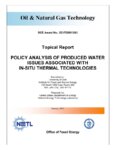Filters: Collection: "ir_uspace"
1 - 25 of 10
| Creator | Title | Description | Subject | Date | ||
|---|---|---|---|---|---|---|
| 1 |
 |
Jones, David T. | Two protozoans from Great Salt Lake | The amoeba inhabiting the waters of Great Salt Lake, which has been previously referred to Amoeba Umax (Dujard in) . Named for mv colleague at the University of Utah, Dr. Seville Flowers. Type localtiv, Garfield Beach, Great Salt Lake, Utah. Type figures 1 to 3. Small amoebae, 18 to 40 micra in diam... | 1944-11-15 | |
| 2 |
 |
Keiter, Robert; Ruple, John; Tanana, Heather | Policty Analysis of Produced Water Issues Associated with In-Situ Thermal Technologies | ABSTRACT Commercial scale oil shale and oil sands development will require water, the amount of which will depend on the technologies adopted and the scale of development that occurs. Water in oil shale and oil sands country is already in scarce supply, and because of the arid nature of the regi... | 2011-01 | |
| 3 |
 |
Woodbury, Angus M.; Cottam, Clarence; Sugden, John W. | Annotated check-list of the birds of Utah | The following check-list is a by-product o f studies made by the writers since 1926 in gathering material for a work on The Birds of Utah which is now completed. The list includes four hundred three kinds of birds (species and subspecies) which are admitted to the actual state list and thirty-three ... | 1949-03 | |
| 4 |
 |
Lenart, Joshua B. | The Uinta Express pipeline: a comprehensive research report conducted by students enrolled in CvEEN 3100 technical communications | The Uinta Express Pipeline is a proposed common carrier pipeline which would transport waxy crude oil extracted from the Uinta Basin in northeastern Utah to area refineries in North Salt Lake City. The proposed project would consist of a 12-inch, buried, insulated, carbon steel pipeline supported by... | Uinta Express pipeline; Feasibility study; Waxy crude oil; Environmental impact assessment | 2015-02 |
| 5 |
 |
Adams, Daniel | Microbial production of methane and carbon dioxide from lignite, bituminous coal, and coal waste materials | The aim of this study was to examine microbial methane and CO2 production from bituminous coal waste, lignite, and bituminous coal materials. Bituminous coal and coal waste material were obtained from a Utah mine and lignite was obtained from a commercially available North Dakota sample. Microbial p... | 2012-01-01 | |
| 6 |
 |
Miller, Jan D. | Nonsulfide flotation technology and plant practice | There are hundreds of nonsulfide mineral flotation plants throughout the United States, and most have a plant design that depends upon the specific ore characteristics and the market specifications for their product. There is no common thread of technology between the design and processing of diffe... | Flotation; Minerals; Processing plants | 2002 |
| 7 |
 |
Keiter, Robert; Ruple, John; Tanana, Heather; Holt, Rebecca | Conjunctive Surface and Groundwater Management in Utah: Implications for Oil Shale and Oil Sands Development | S.J. Quinney College of Law photograph. | 2011-12 | |
| 8 |
 |
Thomas, Tran T. D. | Evaluation of renewable energy technologies and their potential for technical integration and cost-effective use within the U.S. energy sector | Energy demands, environmental impacts of energy conversion, and the depletion of fossil; fuels are constant topics of discussion in the energy industry. Renewable energy technologies; have been proposed for many years to address these concerns. However, the transformation; from traditional methods o... | Renewable energy; Power generation; Electrical grid; Emerging energy systems; System integration | 2017-07 |
| 9 |
 |
Ehleringer, James R. | Plant adaptation in the Great Basin and Colorado Plateau | Adaptive features of plants of the Great Basin are reviewed. The combination of cold winters and an arid to semiarid precipitation regime results in the distinguishing features of the vegetation in the Great Basin and Colorado Plateau. The primary effects of these climatic features arise from how t... | Plant adaptation; Great Basin; Colorado Plateau; Cold deserts | 1992 |
| 10 |
 |
Ehleringer, James R.; Belnap, Jayne | Sensitivity of the Colorado plateau to change: climate, ecosystems, and society | The Colorado Plateau is located in the interior, dry end of two moisture trajectories coming from opposite directions, which have made this region a target for unusual climate fluctuations. A multidecadal drought event some 850 years ago may have eliminated maize cultivation by the first human settl... | Colorado Plateau; Biological crust; Climate change; Megadrought; Ranching; Dry crop productivity; Extractive industries; Pueblo Indians; Fremont culture | 2008 |
1 - 25 of 10
